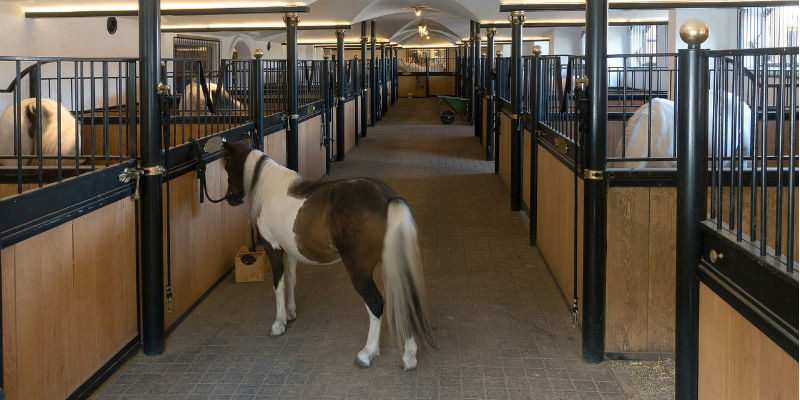What Surface or Flooring is Best for Your Horses?
So you’re thinking about building or renovating your stables and you don’t know what surface you should use for your horse? We can help. Most of the specialists will tell you that one of the most important things for your horse’s health is what they walk on. What a horse walks on has such an impact on their joints. The following is a list of horse stable surfaces commonly used in the United States. For more information, contact Colorado Horse Property today. I you are looking for a horse property for sale, one of our horse-person Realtors® are standing by.
Horse Stable Surfaces
Soil, Sand, or Clay Surfaces
Chances are, your stall has one of these three surfaces. Leaving this surface intact is inexpensive and a healthy option for your horse. However, your floors may require daily upkeep so they stay level. The soil will eventually have to be replaced over time.
Even clay surfaces will require a lot of maintenance in horse stalls. If the clay surface gets wet, it can be dangerously slippery for your horse. Horses dig holes in clay. Therefore, use crushed gravel underneath.
Crushed Limestone Surfaces
Opposed to a more natural surface, this type of surface will have to be installed. Crushed limestone provides good drainage if properly installed with several inches over a bed of sand. It’s also a non-slip surface. However, limestone packs to an almost concrete-like hardness. Stall mats and deep bedding provide comfortable footing for your horse.
Gravel of Crusher Dust Surfaces
Fine gravel or crusher dust can be a comfortable, safe stall flooring. Installers pack and level gravel. The benefit of crushed gravel is that it provides good drainage if properly installed several inches thick. It’s also a non-slip surface.
However, gravel or Crusher dust is not as easy to clean as concrete. Over time the gravel will compact down which means stall mats and/or deep bedding will be needed to provide comfortable footing for your horse.
Asphalt Surfaces
Asphalt is a bit easier on a horse’s legs than concrete and can be made so it drains relatively well. When first laid, asphalt is non-slip, but may become slicker over time. Lay asphalt surfaces thick enough that it does not crack. It’s easy to clean, although disinfecting the porous surface may be difficult. Asphalt may be one of the less-expensive options for stall floors and aisles.
Flooring
Concrete Flooring
Concrete flooring make good horse stable surfaces. It is very durable and easy to clean and is hard to damage. However, concrete surfaces are slippery. Use smooth finished concrete for attractive and easy to sweep in feed and tack rooms. However, textured concrete is better for stalls and aisles.
If horses are kept in for long periods of time, it will be healthier for their legs if rubber stall mats are laid over the concrete, or at very least, the stall is bedded deeply. It also tends to be very cold and damp, so some horses may be reluctant to lie down in their stalls.
Rubber Mat Flooring
Several types of Rubber mats are available for stalls and stable walkways. For starters, hosing down and sweeping equestrian mats is easier than gravel. Cleaning gravel or other natural surfaces is very difficult. A thick rubber mat provides great cushioning for your horse’s legs as well as insulation.
Rubber mats are best if laid over a nice flat surface that drains well. They are often used on top on concrete and usually come in the form of interlocking tiles that can be cut to fit your stalls or chosen area.
Wood Flooring
Wood was once the standard flooring material in horse stables. These floors are easier on a horse’s legs than many other choices. It’s warm, non-slip when dry and has relatively low upkeep. Used treated wood as much as you can. Treated wood prevents rot from urine and water spills. Treated wood also dissuades rodents and bugs from chewing through it.
The wood planks should be at least two inches thick and sit atop a base of sand or gravel for drainage. Fill any spaces between planks with sand so that feed and bedding don’t spill through.
The downside of wood floors is that they can be slippery when wet, they can hold odor, can be damaged by pawing horses and can be hard to disinfect. The cost of plank flooring is one factor that makes this a less popular option than it once was.
Interlocking Brick Flooring
Interlocking brick or pavers are attractive but present the same problems as concrete floors. Because of the grooves between the pavers, they can be a bit harder to clean.
Rubber and synthetic bricks are other options, and these are easy on a horse’s legs, provide good drainage and are non-slip. This is probably the most expensive option for stall and aisle flooring.
Grid Flooring
Several types of grid floors are available for stalls. Installers lay these honeycomb-patterned grids over a few inches of sand or crushed gravel and then fill with crushed gravel or stone dust to make a floor that drains well.

